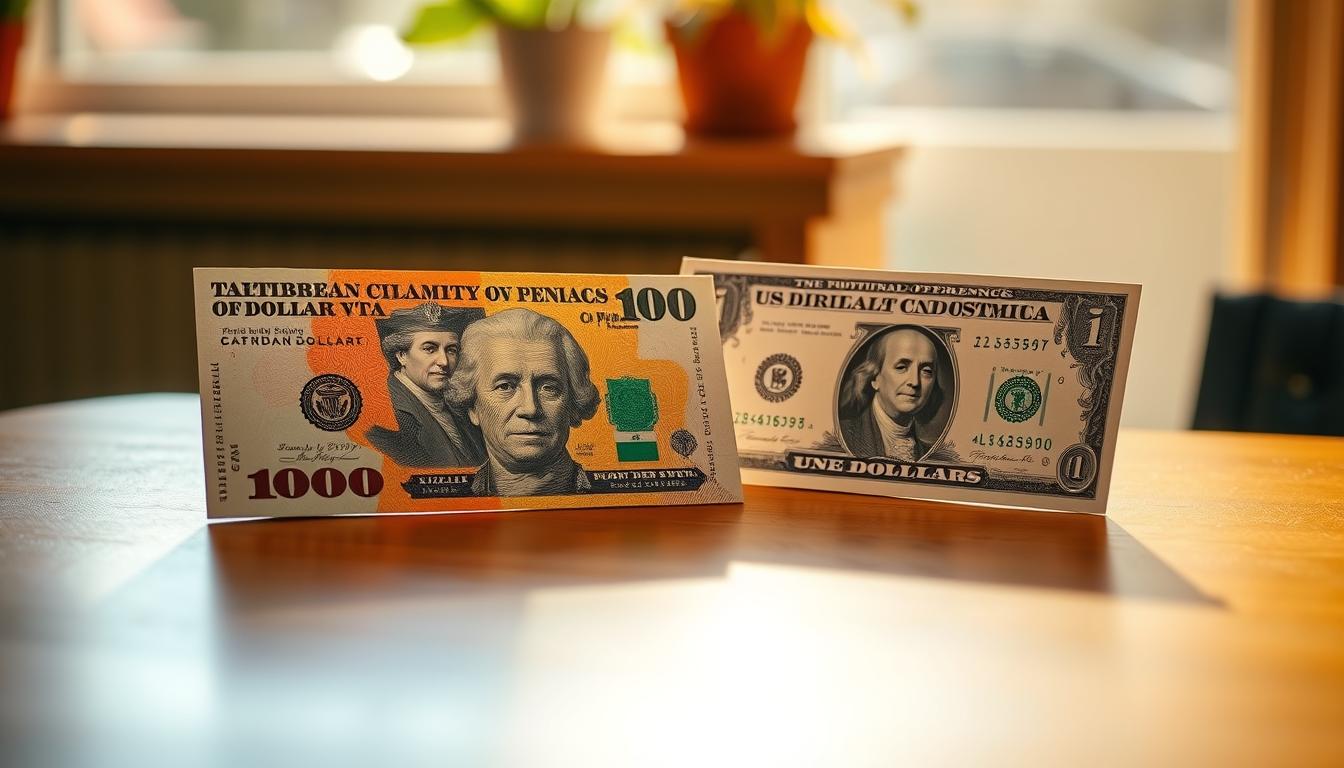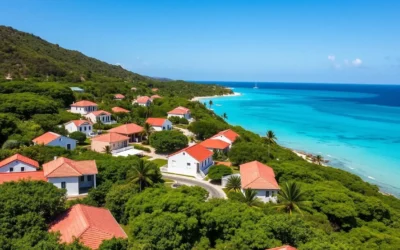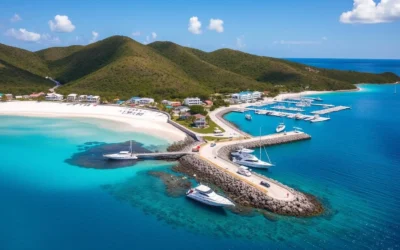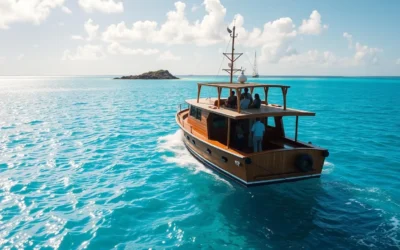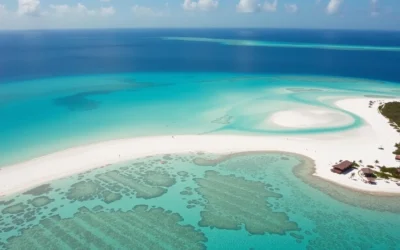✓ Accommodations✓ Flights✓ Rental Cars✓ Tours & Activities
Did you know that Anguilla, a small Caribbean island, operates on a unique dual-currency system? Here, the Eastern Caribbean dollar is the official currency, but the U.S. dollar is widely accepted. This makes it incredibly convenient for travelers from the United States to manage their finances without hassle.
Known for its pristine beaches and turquoise waters, Anguilla is a dream destination for anyone seeking a tropical escape. But beyond its natural beauty, the island’s financial system is designed to make your stay smooth and stress-free. Whether you’re dining at a local restaurant or booking a boat tour, you’ll find that both the caribbean dollar and the u.s. dollar are seamlessly integrated into daily transactions.
This travel guide will walk you through everything you need to know about handling money in Anguilla. From conversion tips to payment methods, we’ve got you covered. Get ready to explore this stunning island with confidence, knowing you’re prepared for every financial detail.
Introduction to Anguilla’s Currency and Payment Systems
Planning a trip to this Caribbean gem? Here’s what you need to know about its currency and payment systems. The official currency is the Eastern Caribbean dollar (XCD), but the U.S. dollar is widely accepted. This dual-currency system makes spending simple for visitors.
The Eastern Caribbean dollar is pegged to the U.S. dollar at a fixed rate of EC$2.6882 to US$1.00. This ensures easy conversions and minimizes confusion during transactions. Whether you’re dining at a local restaurant or shopping at a boutique, you’ll find both currencies seamlessly integrated.
When it comes to payment services, you’ll find local banks and ATMs throughout the island. Major credit cards are also widely accepted, but it’s always a good idea to carry some cash for smaller vendors or remote areas.
Getting here is straightforward. Most visitors arrive via Clayton J. Lloyd International Airport, which handles flights from nearby islands and international destinations. Alternatively, you can take a ferry from neighboring islands like St. Maarten.
For many travelers, visa-free entry is available, making it easy to explore this tropical paradise. However, ensure you have printed reservations and travel-related documents ready for a smooth arrival process.
Here’s a quick overview of essential details:
| Category | Details |
|---|---|
| Official Currency | Eastern Caribbean Dollar (XCD) |
| Accepted Currency | U.S. Dollar (USD) |
| Exchange Rate | EC$2.6882 = US$1.00 |
| Entry Points | Clayton J. Lloyd International Airport, Ferry Services |
| Visa Requirements | Visa-free for many travelers |
With this information, you’re well-prepared to handle your finances and enjoy a hassle-free travel experience. For more tips and insights, continue reading to make the most of your visit anguilla.
History and Evolution of Anguilla’s Currency
The story of Anguilla’s currency is deeply rooted in its colonial past and cultural heritage. The island’s financial system has evolved over centuries, shaped by British administration and local traditions. This blend of influences is evident in the modern usage of the Eastern Caribbean dollar.
During the colonial era, British rule introduced standardized currency systems to the region. This laid the foundation for the financial practices you see today. The heritage collection museum showcases artifacts and exhibits that document this transformation. From old coins to historical records, the museum offers a glimpse into the history of money on the island.
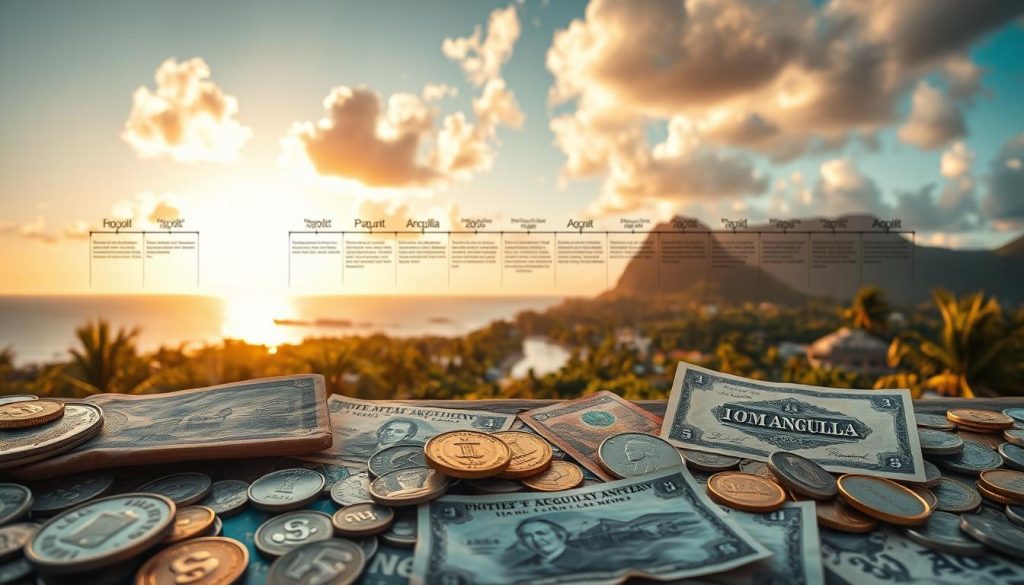
British influence wasn’t the only factor. Local traditions and cultural exchanges also played a role. The Arawak and African heritage of the island contributed to unique economic practices. These traditions are still reflected in everyday financial transactions.
Over time, the island transitioned to the modern Eastern Caribbean dollar. This currency is pegged to the U.S. dollar, ensuring stability and ease of use. The acceptance of multiple currencies today is a direct result of this history.
Visiting the heritage collection museum enriches your understanding of this journey. Exhibits highlight the economic shifts and cultural influences that shaped the island’s financial system. By exploring this anguilla history, you gain a deeper appreciation for its modern-day practices.
Understanding the history of Anguilla’s currency isn’t just about money. It’s about appreciating the cultural and economic forces that have shaped this beautiful island. Whether you’re exchanging currency or shopping locally, this knowledge adds depth to your experience.
Anguilla: Ultimate Travelers Guide to Currencies & Payments
Exploring the financial landscape of this tropical paradise is easier than you think. From booking accommodations to navigating transportation, everything is designed for your convenience. Here’s how to make the most of your trip.
When it comes to accommodations, resorts and villas are the top choices. Many resorts offer all-inclusive packages, while villas provide privacy and flexibility. Booking in advance ensures you secure the best rates and availability. Use trusted platforms to compare options and read reviews before making a reservation.
For currency exchange, always check the current rate to avoid unnecessary fees. Local banks and authorized exchange offices offer competitive rates. Carrying a mix of cash and cards is the best way to handle payments, especially in remote areas.
Transportation is another key aspect. Boat taxis and ferries are popular for island hopping. Book your boat rides in advance to avoid last-minute hassles. Most operators accept both cash and cards, but confirm payment methods beforehand.
Here are some practical tips for managing your money:
- Use credit cards for larger purchases to earn rewards.
- Keep small bills for tipping and local vendors.
- Notify your bank of your travel plans to avoid card issues.
This destination is known for its seamless payment systems, making it easy to focus on enjoying your stay. With these tips, you’re ready to explore confidently and make the most of your trip.
Understanding the Eastern Caribbean Dollar & U.S. Dollar Usage
Navigating the dual-currency system in this Caribbean destination is simpler than you might expect. The Eastern Caribbean dollar (XCD) is the official currency, but the U.S. dollar (USD) is widely accepted. This makes it easy for visitors to manage their finances without constant conversions.
Currency Conversion and Exchange Rates
The Eastern Caribbean dollar is pegged to the U.S. dollar at a fixed rate of EC$2.6882 to US$1.00. This ensures stability and simplifies transactions. When exchanging money, always check the current rate to avoid unnecessary fees.
Local banks and authorized exchange offices offer competitive rates. Carrying a mix of cash and cards is the best way to handle payments, especially in remote areas. Always compare rates before making transactions to get the best deal.
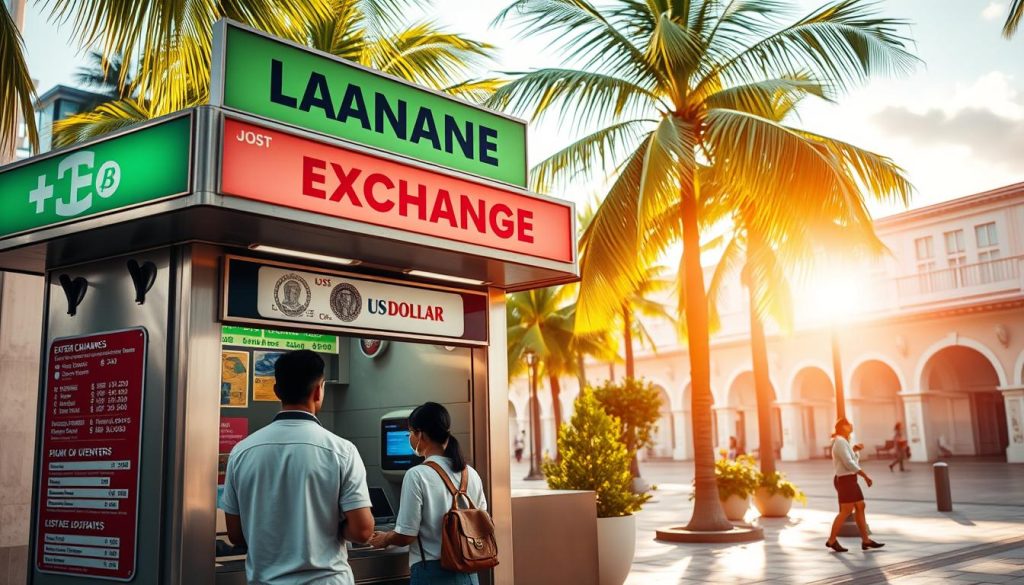
Places Where U.S. Dollars Are Widely Accepted
Many establishments across the island accept U.S. dollars. This includes restaurants, shops, and tour operators. You’ll find that prices are often listed in both currencies, making it easy to understand costs.
For example, local bars and markets typically accept U.S. dollars without issue. However, change may be given in Eastern Caribbean dollars, so it’s helpful to carry smaller bills for convenience.
Here are some practical tips for handling money efficiently:
- Use credit cards for larger purchases to earn rewards.
- Keep small bills for tipping and local vendors.
- Notify your bank of your travel plans to avoid card issues.
With these insights, you’re ready to explore confidently and make the most of your trip.
Where to Exchange Money and Access Payment Services
Managing your finances on the island is straightforward with reliable banking options. Whether you need to exchange currency or withdraw cash, you’ll find trusted services that cater to international visitors. Here’s how to make the most of your financial access during your stay.
Local Banks and ATMs
Local banks are your best bet for secure currency exchange. Institutions like Scotiabank and National Bank of Anguilla offer competitive rates and professional service. These banks are conveniently located in major areas, making it easy to access their facilities.
ATMs are also widely available across the island. You’ll find them in tourist hotspots, near ferry terminals, and in shopping districts. Most ATMs accept international cards, but check with your bank about withdrawal fees beforehand.
Here are some tips for using banks and ATMs efficiently:
- Visit banks during weekdays to avoid weekend crowds.
- Use ATMs in well-lit, secure locations for safety.
- Carry smaller bills for convenience in local markets.
Timing is key. Banks typically operate from 8:30 AM to 3:00 PM on weekdays, while ATMs are accessible 24/7. Planning your visits around these hours ensures smooth transactions.
For added convenience, many service providers cater to international visitors. This includes multi-currency ATMs and extended banking hours in tourist areas. Always use official exchange locations to ensure safety and reliable rates.
“Using trusted banks and ATMs ensures a hassle-free experience when managing your money on the island.”
With these insights, you’re ready to handle your finances confidently. Whether you’re exchanging currency or withdrawing cash, the island’s banking infrastructure has you covered.
Payment Methods in Accommodation, Dining, and Travel
When planning your stay, understanding payment options across accommodations, dining, and activities ensures a seamless experience. Whether you’re booking a hotel, enjoying local food, or exploring the island, knowing how to pay makes your trip stress-free.
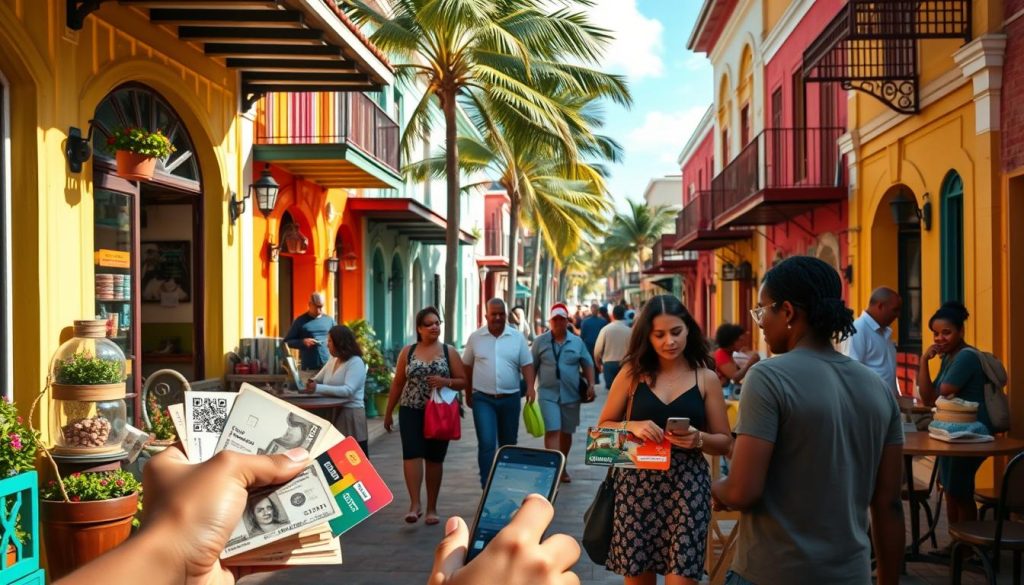
Hotels, Resorts, and Villa Payment Options
Most hotels and resorts accept major credit cards like Visa and Mastercard. Some even offer all-inclusive packages that simplify budgeting. For those seeking privacy, villa rentals often provide flexible payment plans, including deposits and installment options.
Here’s a quick overview of payment methods:
| Accommodation Type | Payment Options |
|---|---|
| Hotels | Credit cards, cash, online payments |
| Resorts | All-inclusive packages, credit cards |
| Villas | Deposits, installments, credit cards |
Restaurants, Bars, and Local Vendors
Dining out is a breeze with multiple payment options. Most restaurants and bars accept both U.S. dollars and Eastern Caribbean dollars. Local vendors often prefer cash, so carrying smaller bills is helpful.
Many bars also feature live music, enhancing your dining experience. Tipping is customary, with 15-20% being the standard for good service.
“Carrying a mix of cash and cards ensures you’re prepared for any payment scenario, whether dining out or exploring local markets.”
For leisure activities like snorkeling or boat tours, integrated payment systems make transactions smooth. Always confirm payment methods when booking to avoid surprises.
Here are some tips for managing payments:
- Use credit cards for larger purchases to earn rewards.
- Keep small bills for tipping and local vendors.
- Notify your bank of your travel plans to avoid card issues.
With these insights, you’re ready to handle payments confidently throughout your stay. Whether you’re relaxing at a resort or exploring the island, managing your finances is simple and stress-free.
Budgeting Your Trip: Financial Tips for Travelers
Budgeting for your trip ensures you can enjoy every moment without worry. Start by setting a daily spending limit. This helps you stay on track and avoid overspending. For example, a midrange budget of around $190 per day covers meals, activities, and accommodations.
Compare prices for food, lodging, and services. Local markets often offer fresh produce at lower costs than restaurants. Pre-made sandwiches and casual take-out meals are affordable options, typically ranging from $7 to $15. Dining at sit-down restaurants can cost between $20 and $50, so plan accordingly.
Monitor exchange rates regularly to maximize your spending. The Eastern Caribbean dollar is pegged to the U.S. dollar, but fluctuations can still impact your budget. Use local banks or authorized exchange offices for the best rates.
Set aside a contingency fund for emergencies. Unexpected expenses, like medical needs or last-minute transportation, can arise. A good rule of thumb is to allocate 10-15% of your total budget for these situations.
Save on extras by choosing free or low-cost activities. Snorkeling gear rentals cost around $7 to $10 per day, while guided hikes or boat tours can be more expensive. Prioritize activities that align with your interests and budget.
Here are some actionable tips to help you manage your finances:
- Track daily expenses to stay within your budget.
- Use credit cards for larger purchases to earn rewards.
- Carry small bills for tipping and local vendors.
- Notify your bank of your travel plans to avoid card issues.
With these strategies, you can explore confidently and make the most of your trip. Whether you’re relaxing by the water or enjoying local cuisine, smart budgeting ensures a stress-free experience.
Navigating ATMs, Banks, and Mobile Payment Solutions
Managing your money while exploring this beautiful destination is simple with modern banking tools. Whether you need cash or prefer mobile payments, the island offers convenient options to keep your finances in check.
ATMs are widely available in key areas, including tourist hotspots and near major transportation hubs. Look for machines operated by trusted banks like Scotiabank or National Bank of Anguilla. These ATMs accept international cards, but always check for withdrawal fees beforehand.
Mobile payment solutions are also gaining popularity. Apps like PayPal and local banking apps allow you to transfer funds quickly. This is a great way to handle payments without carrying large amounts of cash.
Here are some tips for using ATMs and mobile banking efficiently:
- Use ATMs in secure, well-lit locations to ensure safety.
- Notify your bank of your travel plans to avoid card issues.
- Carry smaller bills for tipping and local vendors.
Bank branches are another reliable option for currency exchange or other services. Most operate from 8:30 AM to 3:00 PM on weekdays. Plan your visits during these hours to save time and avoid weekend crowds.
Here’s a quick guide to banking services on the island:
| Service | Details |
|---|---|
| ATMs | Widely available, accepts international cards |
| Mobile Banking | Supported by major apps like PayPal |
| Bank Hours | 8:30 AM to 3:00 PM, weekdays |
By following these tips, you can manage your finances confidently and focus on enjoying your trip. Whether you’re withdrawing cash or using mobile payments, the island’s banking infrastructure has you covered.
Financial Considerations and Visa Requirements
Understanding the financial and visa requirements for your trip can save you time and money. Whether you’re planning a short getaway or an extended stay, knowing the rules ensures a smooth experience. This section covers everything from visa exemptions to environmental levies, helping you prepare for your journey.
Visa Exemptions and Environmental Levies
For U.S. citizens, no visa is required for stays of up to six months. However, you’ll need a valid passport, proof of onward travel, and confirmation of accommodations. Other nationalities should check specific requirements based on their country of origin. Always verify these details well in advance to avoid last-minute surprises.
Upon departure, an environmental levy applies. This fee supports the island’s conservation efforts and is typically paid in U.S. dollars. The exact amount can vary depending on the month or year of travel, so it’s wise to budget for this additional expense.
- Factor in the environmental levy when planning your expenses.
- Keep extra funds for unexpected costs like documentation fees.
- Monitor exchange rates to maximize your spending power.
Gathering the necessary documentation is crucial. Ensure your passport is valid for at least six months beyond your travel dates. Carry printed copies of your reservations and proof of financial self-sufficiency. These steps help you meet all requirement checkpoints smoothly.
“Verifying visa requirements and budgeting for additional fees ensures a stress-free travel experience.”
By planning ahead, you can focus on enjoying your trip without worrying about financial or legal hurdles. Whether you’re staying for a month or a year, these tips will help you navigate the process with ease.
Additional Traveler Tips for Smooth Transactions
Ensuring smooth transactions during your trip involves more than just carrying cash or cards. It’s about safeguarding your valuables, managing your documents, and staying prepared for unexpected situations. Here are some practical tips to help you navigate your journey with confidence.
Securing Your Valuables and Financial Documents
Protecting your valuables is essential for a stress-free trip. Always use the in-room safe at your accommodation to store passports, extra cash, and important documents. Carry photocopies of your ID and travel insurance in case of emergencies.
When exploring crowded areas like Meads Bay, stay vigilant. Keep your belongings close and avoid displaying large amounts of cash. Consider using a money belt or anti-theft bag for added security.
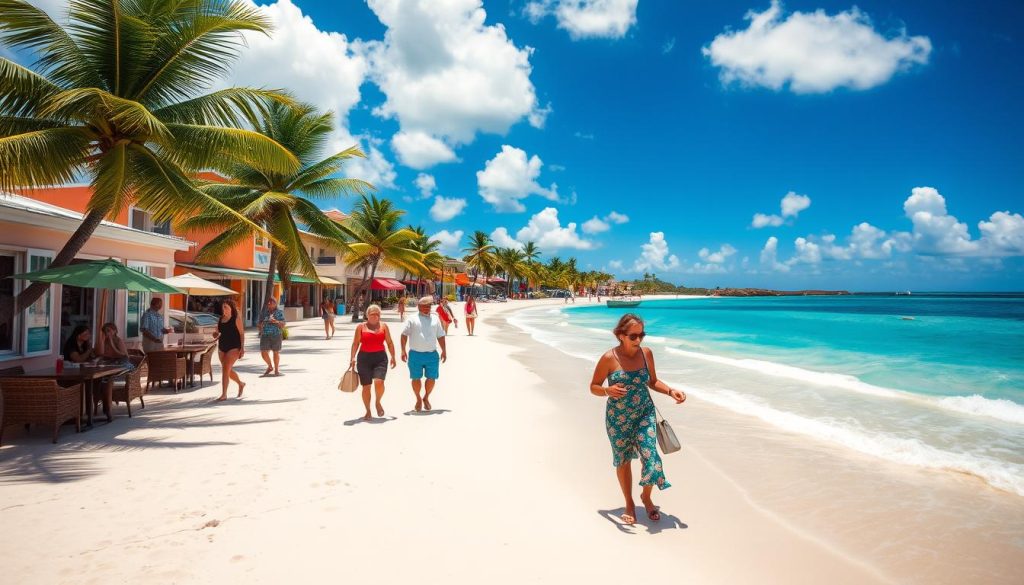
- Lock valuables in your hotel safe or a secure locker.
- Carry extra copies of important documents in a separate bag.
- Use secure payment methods like contactless cards or mobile wallets.
Planning for Payment Flexibility and Emergencies
Flexibility is key when managing your finances. Always carry a mix of cash and cards to handle different payment scenarios. Notify your bank of your travel plans to avoid card issues while abroad.
Unexpected expenses can arise, especially near popular sites like Meads Bay. Set aside a small emergency fund for activities, transportation, or last-minute needs. This ensures you’re prepared for any situation.
“Planning ahead and staying flexible with your payment options can save you from unnecessary stress during your trip.”
Here’s how to stay prepared:
- Keep small bills for tipping and local vendors.
- Monitor exchange rates to maximize your spending power.
- Use credit cards for larger purchases to earn rewards.
By following these tips, you can enjoy your time on the island without worrying about financial hiccups. Whether you’re relaxing at Meads Bay or exploring other attractions, these strategies ensure a smooth and secure experience.
Conclusion
Handling money while visiting this Caribbean destination is straightforward and stress-free. The dual-currency system ensures you can use both the Eastern Caribbean dollar and the U.S. dollar seamlessly. This guide has provided comprehensive insights into managing your finances, from currency exchange to budgeting tips.
Understanding the historical context of the local currency adds depth to your experience. Accessing banking services, ATMs, and mobile payment solutions is simple, ensuring you’re always prepared. Planning ahead and securing your valuables are key to a smooth trip.
With these tips, you can focus on enjoying your stay without financial worries. Feel free to revisit this guide for last-minute advice before your departure. Wishing you a memorable and financially stress-free journey!
The above is subject to change.
Check back often to TRAVEL.COM for the latest travel tips and deals.
